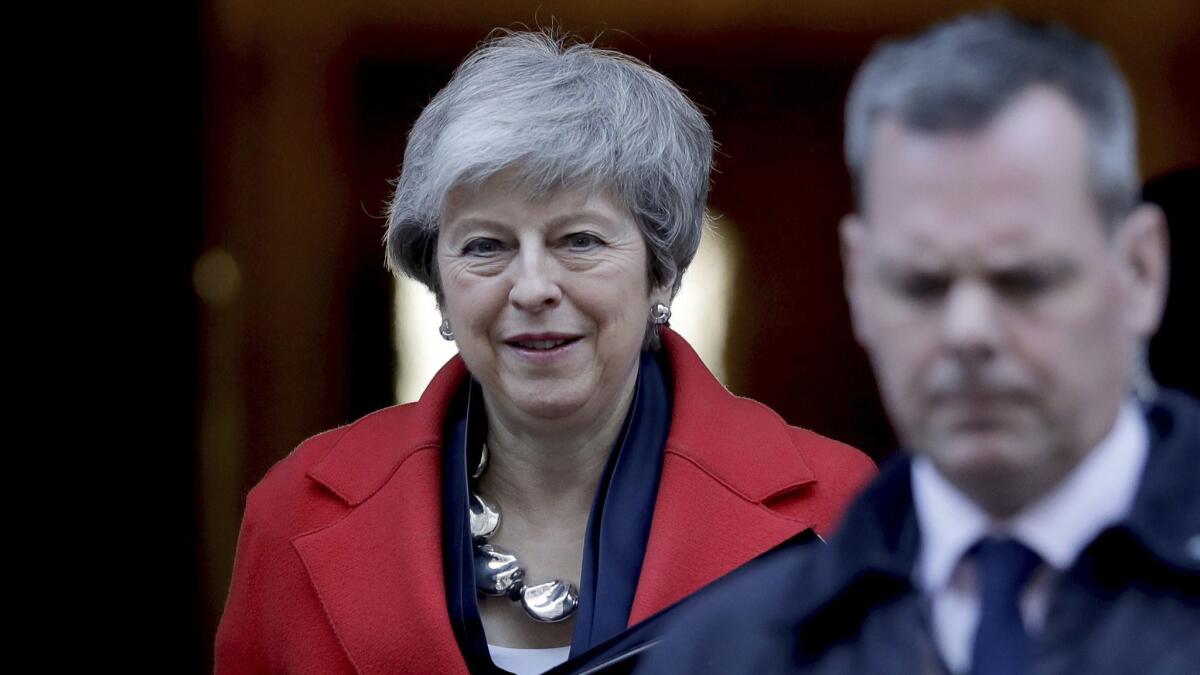Theresa May to let Parliament decide Brexit’s fate; no-deal and delay votes set

Reporting from London — British Prime Minister Theresa May may have staved off a political and economic disaster, at least for the moment, by putting the future of any Brexit deal squarely in the hands of Parliament.
Backed into yet another corner by the threat of a Cabinet revolt, resignations within her party and renewed momentum for a second Brexit referendum, May on Tuesday offered lawmakers a chance to delay leaving the European Union should her revised exit plan fail to be approved by Parliament next month.
The move was a critical turning point for the prime minister, who until now has vehemently ruled out the idea of extending the March 29 deadline when Britain is due to formally leave the EU, severing decades of membership in the body and close political and economic partnership.
“Our absolute focus should be on working to get a deal and leaving” on the date agreed, May told lawmakers defiantly in the House of Commons.
Yet, she made three crucial commitments: Lawmakers will get to vote on her amended withdrawal deal by March 12; if that is rejected, they will be given a vote on leaving the EU without any deal within at least two days; and they will also have the opportunity to extend the deadline beyond March 29.
The announcement made the threat of Britain crashing out of the EU without any deal less likely — though not impossible — as a large majority of Parliament is ardently opposed to such an outcome. The British pound reached a 21-month high against the euro at the news.
The move is also likely to have quashed a potential revolt by May’s pro-European Cabinet colleagues. Those Cabinet members — Greg Clark, David Gauke and Amber Rudd — indicated over the weekend that they were thinking of backing a cross-party amendment that would give Parliament the power to decide the timetable for Brexit and thereby could stop the country from crashing out without a deal.
But even if that amendment is defeated Wednesday when it comes up for a vote, May could find that she has only created a temporary fix to an intractable problem.
She continues to face pressure from the hard-line Euroskeptic wing of her party that wants to leave the EU at virtually any cost, and view it as a staid, bureaucratic organization that is holding Britain back.
Meanwhile, the pro-remain members of her party are also becoming more vocal and unified as the March 29 deadline looms ever closer. They have been displeased with the impact the ongoing Brexit turmoil has had on the economy and business sector.
Last week, three pro-EU lawmakers resigned from the Conservative Party to join a newly formed independent group started by eight lawmakers who quit the opposition Labor Party over similar dismay at the direction in which their party was going.
One of those former Conservatives, Sarah Wollaston, said that May’s concession to Parliament on Tuesday only gave the country the “possibility of a short gangplank added to the cliff edge” that is Brexit.
In another headache for May, after failing to take a definitive stand on Brexit for months, Labor Party leader Jeremy Corbyn gave the campaign for a second referendum — or a “people’s vote” — a boost Monday evening. He declared that he would throw his party’s weight behind another referendum if the Labor Party’s own version of an EU withdrawal bill fails to pass this week, as seems likely.
May slammed the idea, saying another referendum would be “divisive” and take the country “right back to square one.”
Indeed, the wounds caused by the 2016 referendum — in which 52% of the country voted to leave the EU and 48% voted to remain — still run deep.
May’s original withdrawal agreement was resoundingly rejected by Parliament in January and she has spent the fraught weeks since meeting with EU leaders and negotiators in the hope of securing key concessions, especially around the contentious issue of the border between the Republic of Ireland and Northern Ireland.
The former will remain an EU member while the latter will leave the EU along with the rest of Britain, creating a land border in a region once marred by years of bloody sectarian conflict.
May has just spent the last week meeting with EU leaders in Egypt, where she said she made Britain’s position clear and is confident she can get the assurances she needs to win support back home.
But it is unclear how far the EU is willing to go to help solve the Brexit dilemma in Britain.
Any changes to the withdrawal agreement would have to again be agreed upon unanimously by all remaining 27 EU members, and they have repeatedly said that the deal on the table is the best Britain is going to get.
Boyle is a special correspondent.
More to Read
Sign up for Essential California
The most important California stories and recommendations in your inbox every morning.
You may occasionally receive promotional content from the Los Angeles Times.










